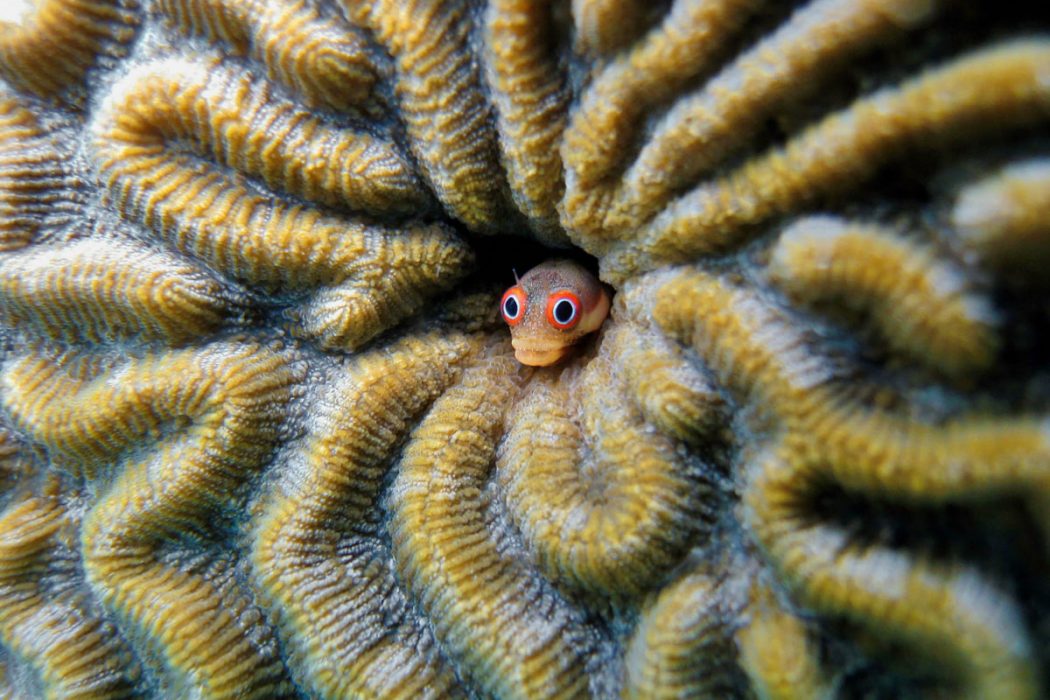When full grown they vary in length from less than one-fifth of an inch/1 cm to almost 50 feet/16m. Their weight ranges from being so small they are almost immeasurable to roughly 30,000 pounds/13,636 kg. Some prey upon seals, sea lions, dolphins and billfish, while others feast on the tiniest forms of plankton. Some are highly migratory, covering thousands of miles each and every year of their lives, while others hardly move at all. Some are extremely territorial year-round, while others are only territorial during their breeding season. Many others display no territorial desires at all. Some eat their young. Others guard their young by holding them in their mouth while they are too small or undeveloped to protect themselves.
Some are vividly colored and stand out quite prominently. Others are quite drab and blend in well with their surroundings. Some live in the vast expanse of the open sea, rarely, if ever, coming within view of the sea floor, while others live on or near the bottom. Some live in extremely cold polar seas, while those that we are most familiar with inhabit temperate and tropical oceans. Some inhabit salt water, others live in fresh water, and still others have the remarkable ability to live in both. Most live in schools as juveniles, but as adults, most do not. Almost everywhere we dive, they provide us with endless hours of entertainment.
They, of course, are fishes. Worldwide, there are more than 23,800 species. With such a large and varied group of creatures, trying to describe a typical fish is quite a challenge. In fact, if there is a single concept that describes all fishes, it surely must be that of diversity. To gain some handle on just how diverse fishes are, take a moment to think of how many different shapes can be seen in fishes. Of course, body plan is closely tied to lifestyle, and with so many body designs it is easier to understand how many different niches fishes inhabit and how diverse fishes are.
The bodies of many fast-swimming fishes such as jacks and mako sharks are said to be fusiform, rounded toward the center and tapered toward the head and tail. A laterally compressed body like those found in groupers, snappers and butterflyfishes is one of the most common fish shapes. These species are well- equipped to slip into the crevices in reefs and for rapid bursts of speed. Lizardfishes, barracudas and wrasses have a body plan that is more elongated and only slightly compressed. These species also rely heavily upon sudden bursts of speed to help them capture mobile prey.
Angelsharks, halibut, flounder and sole have bodies that are greatly flattened from top to bottom or dorsoventrally compressed, a body plan that helps them hide on the sea floor. Eels have a snakelike, or anguilliform, body plan that helps these predators squeeze in and out of the tight confines of a reef. Sand tile fish have a ribbonlike shape, and other fishes such as cowfishes and trunkfishes are more box-shaped. Puffer fishes and frogfishes are said to have globelike bodies. Globe-shaped fishes are not the fastest swimmers, and they tend to rely on other adaptations to capture prey and escape predation.
While fishes vary dramatically in terms of their shape, size and many other characteristics, it is the possession of fins that immediately distinguishes fishes from other vertebrates (animals with backbones). Only a few species of fishes have lost their fins. In most fishes the fins are flexible and highly controllable. Fins enable fishes to hover, swim forward, backward and execute a wide range of precise swimming movements.
RELATED READ: WHAT MAKES A FISH A FISH?
There Is More Than One Way to Get Underway
Water is approximately 800 times more dense than air, and moving through such a dense medium efficiently requires a variety of adaptations.
Most fishes use the side-to-side oscillating movement of the tail and body to create forward thrust. This motion is easily seen in species such as yellowfin tuna and blue sharks, while in eels it is the undulating movement of the body that propels the animal forward. Wrasses, surgeonfishes, parrotfishes and some other species use their pectoral fins as a major source of power, while most sharks use their pectoral fins as hydroplanes to provide lift and control fine movements.
Even with bodies that are designed to be very efficient when swimming, creating a forward thrust in such a dense medium requires comparatively large, powerful muscles. In fact, swimming muscles make up between 40 and 65 percent of the body weight of most fishes.
Modern Fishes
There are four major classes of fishes. They are 1) the bony fishes, class Oestiechthyes; 2) the cartilaginous fishes; class Chrondrichthyes; 3) the roundmouth fishes such as lampreys, class Cyclostomata; and 4) the hagfishes, class Minixi. As divers, we tend to be interested in bony fishes such as angelfishes, damselfishes and tunas, and in cartilaginous fishes, the sharks, rays and skates, because we encounter them on a regular basis.
In terms of total species, bony fishes are far more numerous than their cartilaginous cousins. There are just over 1,000 species of sharks, rays and skates, and there are more than 22,000 species of bony fishes. The major difference between bony fishes and cartilaginous fishes is that the skeletons of all bony fishes are made of bone, while the skeletons of all sharks, rays and skates are made of cartilage. This means that the world’s largest fishes, the whale shark and basking shark, like all their cartilaginous cousins, such as manta rays, spotted eagle rays and stingrays, do not have a single bone in their entire body!
Fossil studies have shown that cartilaginous fishes first appeared on Earth approximately 450 million years ago. Until only recently it was commonly believed that bony fishes did not appear until 120 to 150 million years ago, but recent discoveries suggest that they have roamed the waters of Planet Earth for as long as 380 million years.
However, you want to be careful when interpreting and applying this information. The vast majority of species of ancient fishes no longer inhabit the seas. Modern fishes are said to be roughly as old as 120 million years.
That is why a fish called a coelacanth is such a newsmaker. Fossil evidence suggests that this species first appeared more than 350 million years ago. However, their fossil record abruptly ends approximately 65 million years ago, and for many years it was assumed that the species was extinct. Astonishingly, a living coelacanth was caught off South America in 1938, and more living specimens have been documented within the past several years.
Even Fish Have to Deal with Buoyancy Control
In addition to the composition of their skeletons, bony fishes and cartilaginous fishes differ in a number of other ways. Many bony fishes possess an internal organ known as a swim bladder. Absent in all sharks, rays and skates, the swim bladder helps bony fishes maintain neutral buoyancy as the organ adds or subtracts gases from the bloodstream, thereby expanding or contracting as a fish alters its depth. A swim bladder is a great energy saver for fishes with relatively heavy, bony skeletons. Groupers, snappers, hogfishes and many other bony fishes are able to hover in the water without expending much energy, and they can quickly change their depth without losing buoyancy control. This ability allows predators to maintain control when they make a rapid vertical rush at potential prey near the surface, where pressure is changing quickly.
However, not all bony fishes have a swim bladder. Most bottom-dwelling species do not because they do not usually need to rapidly alter their buoyancy.
If sharks, rays or skates stop swimming, they will sink. A lighter-weight skeleton made of cartilage is one adaptation that helps sharks, rays and skates combat the potential problem that results from the lack of a swim bladder. However, many sharks and rays, especially those that inhabit the open ocean, such as oceanic whitetip sharks and manta rays, must swim all day, every day of their lives, to avoid sinking.
Methods of Reproduction
Fishes reproduce in more diverse ways than any other group of animals, so it should come as no major surprise that bony fishes and cartilaginous fishes also differ markedly in terms of their reproductive strategies. Most bony fishes reproduce through external fertilization using a variety of spawning strategies. Complex displays intended to attract a potential mate are part of the elaborate courtship rituals of many fishes.
In some bony fishes such as garibaldi, sergeant-majors and anemonefishes, the females lay eggs in nests after being wooed by an amorous male. The eggs are then fertilized by the male. In other species such as rainbow wrasses, convictfish and jacks, males and females gather in dense groups to release great quantities of sperm and eggs into the water column, where sexual union occurs.
Fishes such as salmon reproduce only once in their lifetime, and mating is a cathartic event. In contrast, individuals of many other species spawn daily, and still others spawn seasonally. Ocean sunfish produce as many as 28 million eggs per season, while mature females in many species of sharks produce fewer than a half-dozen eggs in a given year.
Sharks, rays and skates reproduce by internal fertilization, meaning the males deposit sperm inside the female. Often the act of copulation is quite violent. Males commonly bite the females on or near their pectoral fins in order to get a good grip on the body before inserting a clasper.
Identifying the gender of cartilaginous fishes is relatively easy if you get a look at the underside of the belly. In all cartilaginous fishes, the males possess a pair of claspers, organs through which sperm is delivered to the females. The tubelike organs are located roughly three-quarters of the way down the body on the underside of sharks, and near the base of the tail in rays and skates. Females lack claspers, but you will often be able to see a slit in the underbelly where the claspers are positioned in males of the same species.
The topic of sex and reproduction in fishes is far too complex to cover in an introductory overview, but a few examples will shed some light on just how complicated the topic is. Most fish are born male or female and will remain the same throughout their lifetime. However, there are plenty of exceptions to this rule. In sheephead and other members of the wrasse family, every individual is born as a female, and sexually functioning males are produced by a mid-life sex reversal from female to male. This phenomenon is known as protogyny.
In anemonefishes and a variety of other families, every individual is born a male. Sexually functioning females are produced through mid-life sex changes in a phenomenon known as protandry. The timing of the sex reversal in both protogyny and protandry is often determined by the needs and social interactions of a local population.
While mid-life sex reversal is rather fascinating, it is not by any means the only eyebrow-raiser in the complicated world of fish reproduction. In some species of mollies, every fish is a female. That’s right — there are no males. The female molly seduces the male of other species to trigger the development of her eggs, but there is no union of sperm and egg. The male of the other species does not contribute genetically to the offspring, but his passion stimulates the female molly’s eggs to develop. The world of fishes is a wonderful, wacky world indeed!
One other major point about reproduction in fishes needs to be made. The number of offspring produced over the course of a lifetime varies tremendously from species to species. Many bony fishes produce thousands of young in a very short period of time. However, many sharks, rays and skates produce litters of a dozen or fewer, and in many cases these animals do not breed every year. In addition, it often takes cartilaginous fishes years longer to reach sexual maturity.
The bottom line here is that because of the great differences in their reproductive strategies, we cannot afford to exploit all fishes in the same manner. It is far too easy to wipe out a population of sharks in a very short period of time. Sadly, current fishing practices do not always address the biology of targeted, highly marketable species.
A Few More Differences
On the whole, fishes have extremely efficient respiratory systems. They use their mouths to suck in oxygen-rich water so that it will pass over their gills and out their gill slits. As much as 95 percent of the oxygen taken in is extracted and used, making the respiratory efficiency of fish gills the highest among all water-breathing animals.
The gill slits of most bony fishes are covered by a bonelike flap called an operculum. This flap is moved back and forth to help pump oxygen-rich water over the gills. Sharks, rays and skates do not have an operculum. Instead, they have five to seven gill slits on either side of their head. As a result, many sharks, rays and skates must swim to wash oxygen-filled water over their gill tissue. In fact, members of some species swim all day, every day of their lives, from the time they are born until they perish, in order to respire.
The skin of bony fishes is covered by protective scales. In more primitive fishes such as tarpon, the individual scales are comparatively large, and they can easily be seen with the naked eye. Cartilaginous fishes lack scales. Instead, their skin is comprised of small, toothlike structures called dermal denticles (skin teeth).
In their developmental process, the skin of sharks, rays and skates grows from the mouth back. When viewed with even a slight magnification, it is quite easy to see that the skin of all sharks, rays and skates looks like a collection of miniature teeth that are all aligned in the same direction. That is why shark skin feels as smooth as velvet if rubbed in one direction and as rough as sandpaper if rubbed against the grain in the opposite direction.
Another rather obvious difference between bony fishes and cartilaginous fishes is the position of the mouth. In most bony fishes the mouth is located at the front of the body in what is called the terminal position. In most cartilaginous fishes the mouth is located below the snout and is said to be underslung. Whale sharks, horn sharks, angelsharks and manta rays are exceptions to this rule.
Fish Sense
Fishes routinely rely on a combination of the senses of sight, feel, taste, hearing and smell in their daily lives. Which sense is most important varies from species to species and from moment to moment depending on a variety of circumstances.
Sight is extremely important to many species that live in relatively shallow, clear water, while, as might be suspected, vision is comparatively unimportant to many species that inhabit darker, more turbid waters. The eyes of fishes are well-developed and are similar to human eyes in many respects. One major difference is that fishes are able to move each eye independently, and each eye can be rotated so that the fish can see over a very wide field of view.
The ability to see a wide field is extremely valuable in a dangerous world, where potential predators can strike from all directions. As a rule of thumb, the ability to see and distinguish colors is thought to be much more highly refined in bony fishes than in sharks, rays and skates. However, it is known that sharks such as lemon sharks and great white sharks do have some color vision.
All fishes possess a system of nerves and specialized organs that runs down the mid-line of the outside of their bodies. Called the lateral line, this sensory system enables fishes to feel pressure waves caused by the motion of other animals and objects. The system is very sensitive, and many fishes are able to analyze and respond extremely quickly to input received by their lateral line system. By detecting motion, the lateral line system is thought to play a major role in the effort to avoid potential predators. It also allows schooling fishes to swim in close proximity to one another while making instantaneous turns — without crashing into one another.
The lateral line system is thought to be more highly developed in bony fishes than in cartilaginous fishes. However, sharks, rays and skates partially compensate for their underdeveloped lateral line with a group of specialized organs known as ampullae of Lorenzini. The pinhead-sized ampullae look like gel-filled pits, and they are extremely sensitive to pressure changes and the presence of electrical fields. In fact, sharks have the amazing ability to detect electrical fields that are 10,000 times more faint than those that can be detected by any other known group of animals. Biological functions such as a beating heart and other muscular contractions create electrical fields that surround all living creatures. The detection of an electrical field translates into potential prey for sharks and is one factor that helps to make them adept predators.
In recent years it has been realized that the famous “silent world of Jacques Cousteau” is really anything but quiet. As any scuba diver quickly learns, the marine environment is filled with noise, so it should not be too surprising that sound plays an important role in the lives of many fishes. For example, croakers, squirrelfishes, grouper and triggerfishes produce loud grunting sounds that are believed to be an important part of their communication. The grunt produced by an alarmed squirrelfish is thought to serve as warning to other squirrelfish that danger is present.
Seasoned fishermen are well aware that noise created in a boat of clumsy peers often means that if they expect to have fish for dinner, they better make reservations at a nearby restaurant. Similarly, observant divers are aware that the noise from scuba exhaust can have the same effect.
Smell is heavily relied upon by many fishes. Moray eels, for example, use their sense of smell to help locate prey. Some parrotfishes spin a cocoon of mucus around their body when they sleep in order to mask their odor, making it more difficult for potential predators to detect their presence. Interestingly, octopuses often emit ink when threatened by an eel, not only as a sight-impairing smoke screen, but also because chemicals in the ink are known to dull the olfactory senses of eels. In addition, some fishes are known to emit chemicals that have a detectable odor intended to warn other members of their species of impending danger.
Studies have shown that taste is not relied upon as heavily as are the other senses in most fishes. Clearly, many fishes are extremely sensitive to touch, and they will flee upon contact with a foreign object such as a fishing hook.
The more you learn about fishes, the more obvious it becomes that they are an extremely diverse group of animals. When trying to write about fishes, the diversity poses quite a challenge because it is very difficult to make flawless statements that apply to all fishes. Once you get beyond something like aquatic vertebrates, there always seem to be exceptions to any general statement. But from a sport diver’s point of view, it is in part the diversity of design, adaptations, behaviors and environmental niches occupied that makes fishes such a fascinating group of animals to observe and learn about. The more we do, the more obvious it becomes that we all have so much more to learn about the wonderfully wacky world of fishes.
How Fishes Use Color
While the rich colors of “chromatically blessed” fishes such as angelfishes, grunts and basslets are certain to capture our attention, scientists do not completely understand how fishes use their coloration. Some bony fishes are thought to use their vivid coloration to advertise their presence, to advertise territoriality and to use color-filled displays to help avoid actual physical confrontations.
In some cases, brilliant colors are thought to serve as a warning that essentially says, “I am here. Leave me alone.” In many other species, coloration and patterns are used to help individuals blend into their surroundings and go undetected. In open ocean, sharks such as mako sharks, blue sharks and silky sharks have an underbelly that is an off-white, while the top and back of the animal is gray to blue. When viewed from below, the lightly hued underbelly helps these sharks blend with lightly hued surface waters above. When viewed from above, their dark backs help them blend with darker water below. This type of coloration is known as countershading.
In many species, males and females are different colors, a factor that helps in attracting, selecting or rejecting a potential mate. Different colors and color patterns in adults and juveniles of the same species also help to identify and reject potential mates.
Many species of reef fishes “flash” or change colors as part of a communication process when requesting to be cleaned by a variety of cleaner shrimps and cleaner fishes. Once satisfied that the cleaning is complete, they change color and pattern again.
However, not all colorful fishes are territorial, and not all colorful fish display their bright colors all the time. The color changes in bony fishes are governed by specialized cells in the skin called chromatophores. These cells are directly connected to the fish’s nervous system. As a result, fishes are able to contract or expand each cell, bringing about nearly instantaneous color changes. Many species of flatfish such as turbot and flounder, as well as scorpionfishes, commonly change their color to match that of their surroundings. This ability indicates that the eyes of these fishes are somehow connected with the nerves that control color cells.
When trying to gain an understanding of how fishes use colors, it is important to realize that the eyes of fishes are different than human eyes, so the visual acuity and color perception of fishes is different than our own. In addition, the eyes of various species differ considerably with regard to their ability to see and use color.






